Abstract
An international workshop reviewed 20 ongoing or recently completed studies of the effects of perinatal exposures to dioxins, dibenzofurans, and PCBs on the reproductive, endocrine, neurodevelopmental, and immune systems. Many of the observed effects are consistent with these compounds acting as "environmental hormones" or endocrine disrupters. This report summarizes the conclusions and future directions described at the workshop.
Full text
PDF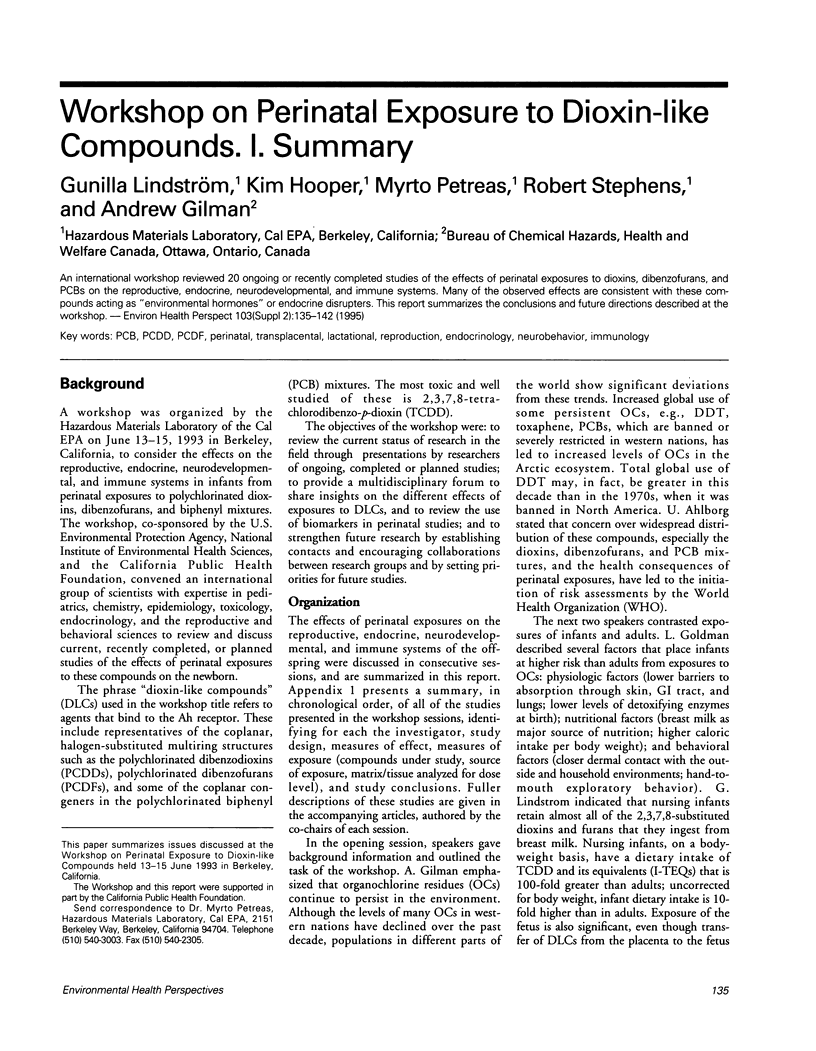
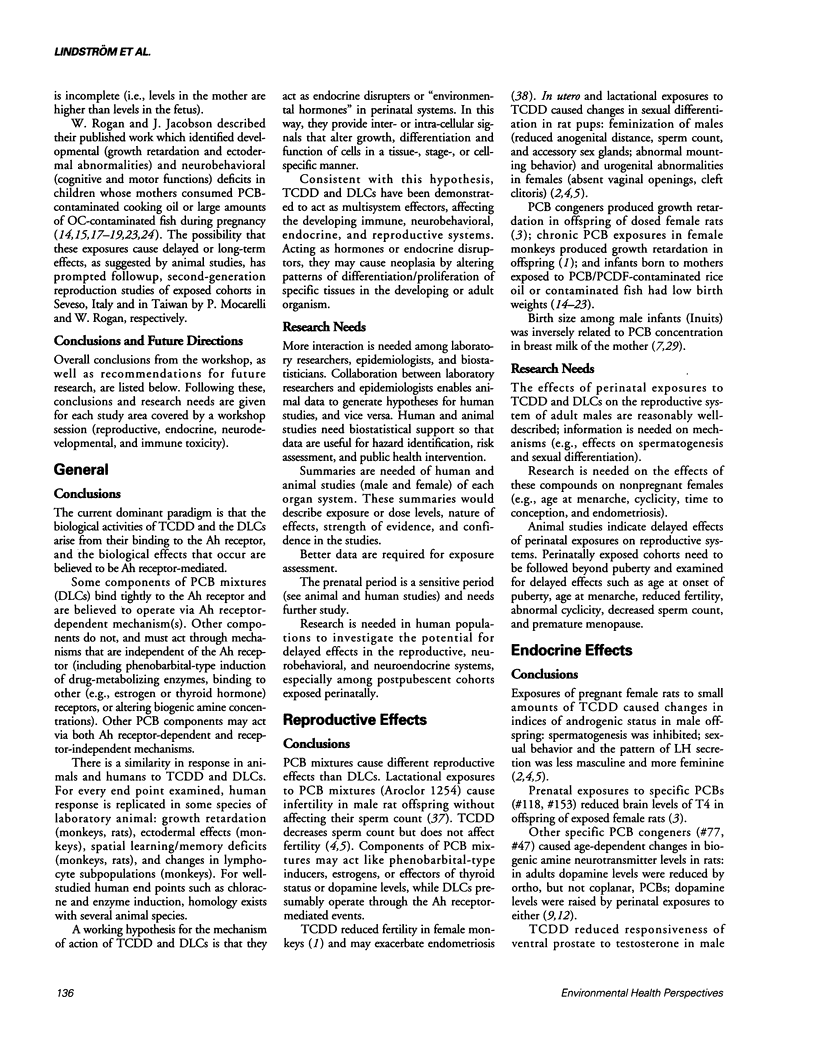
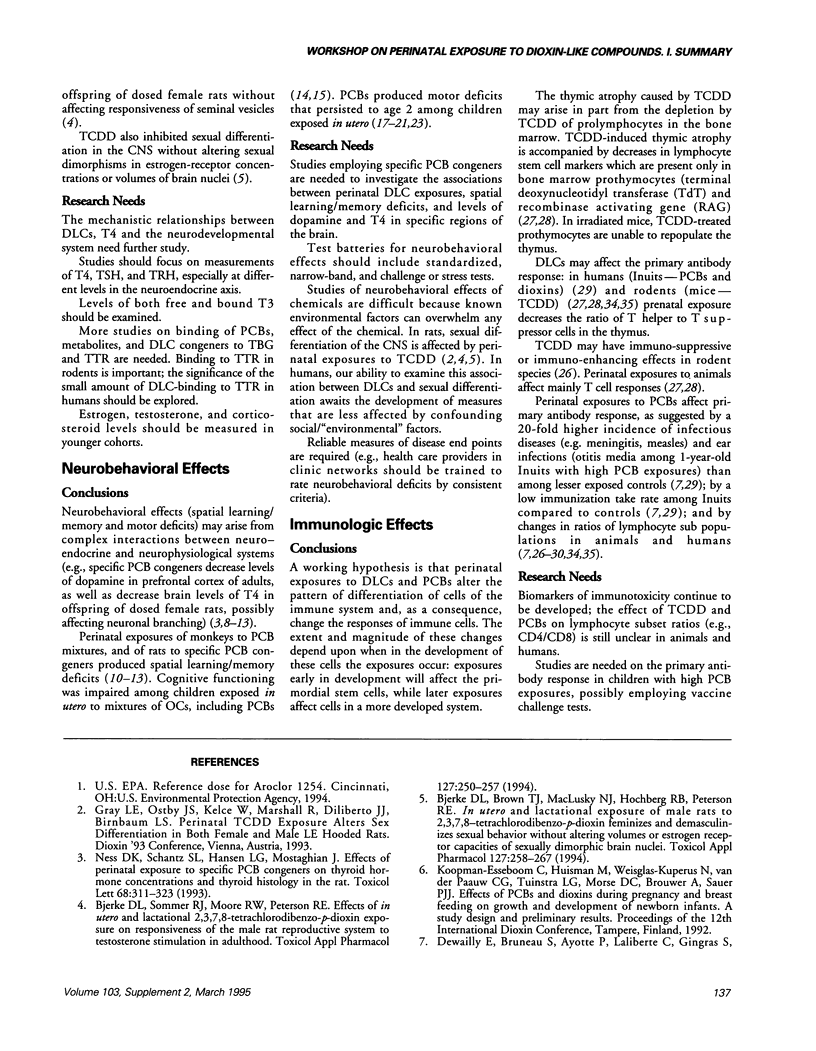
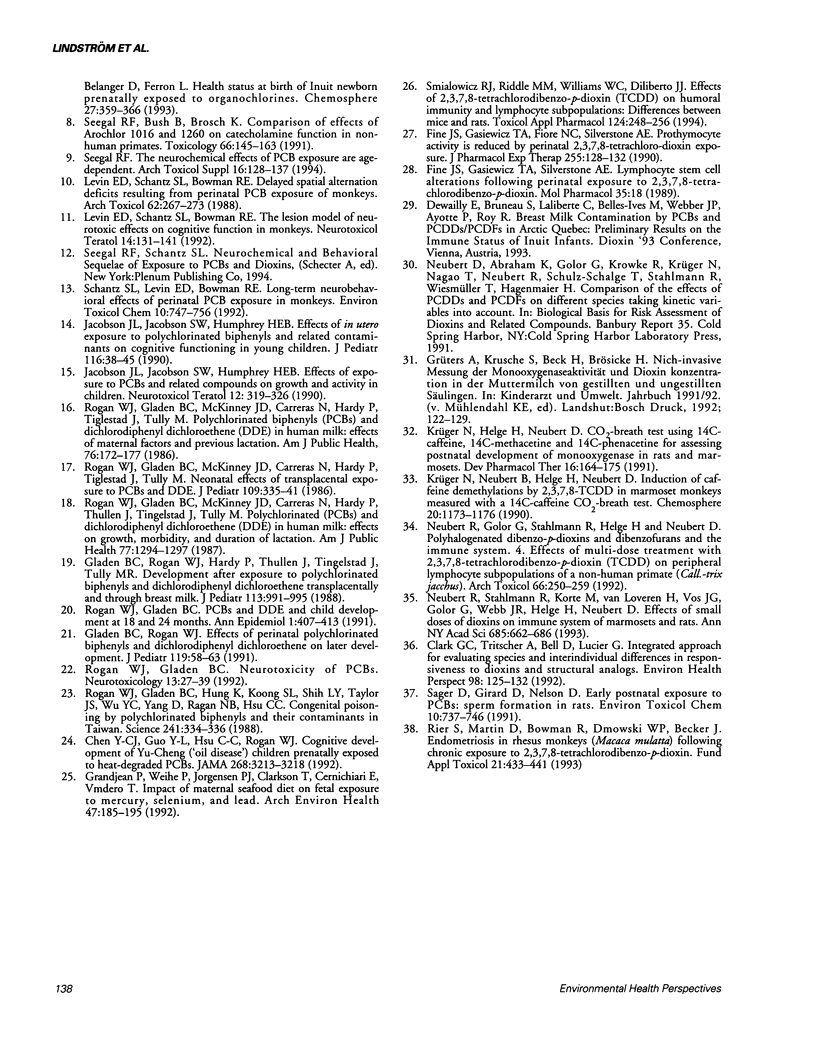
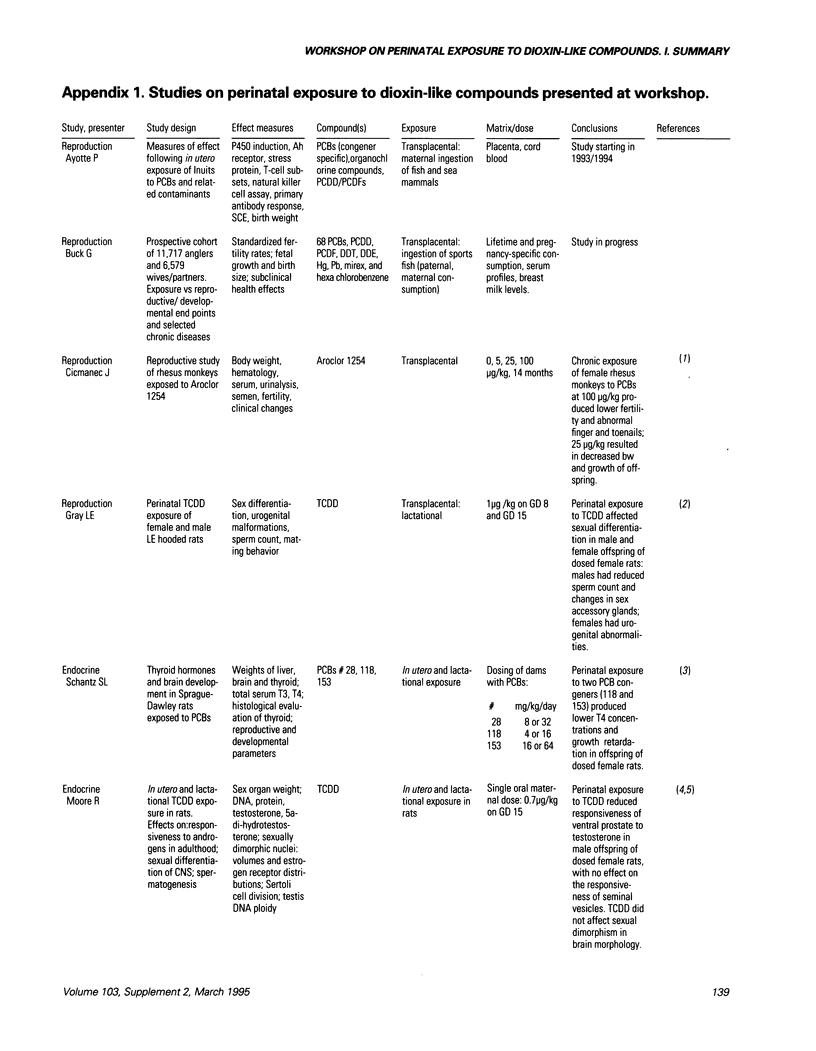
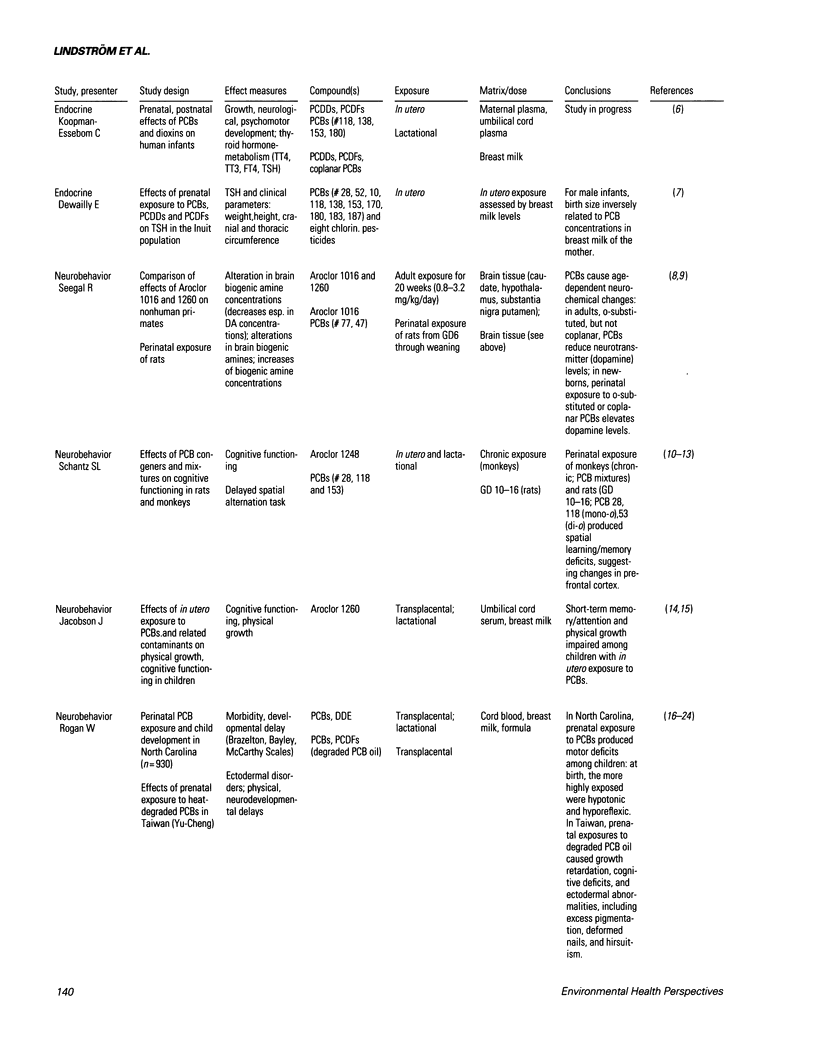

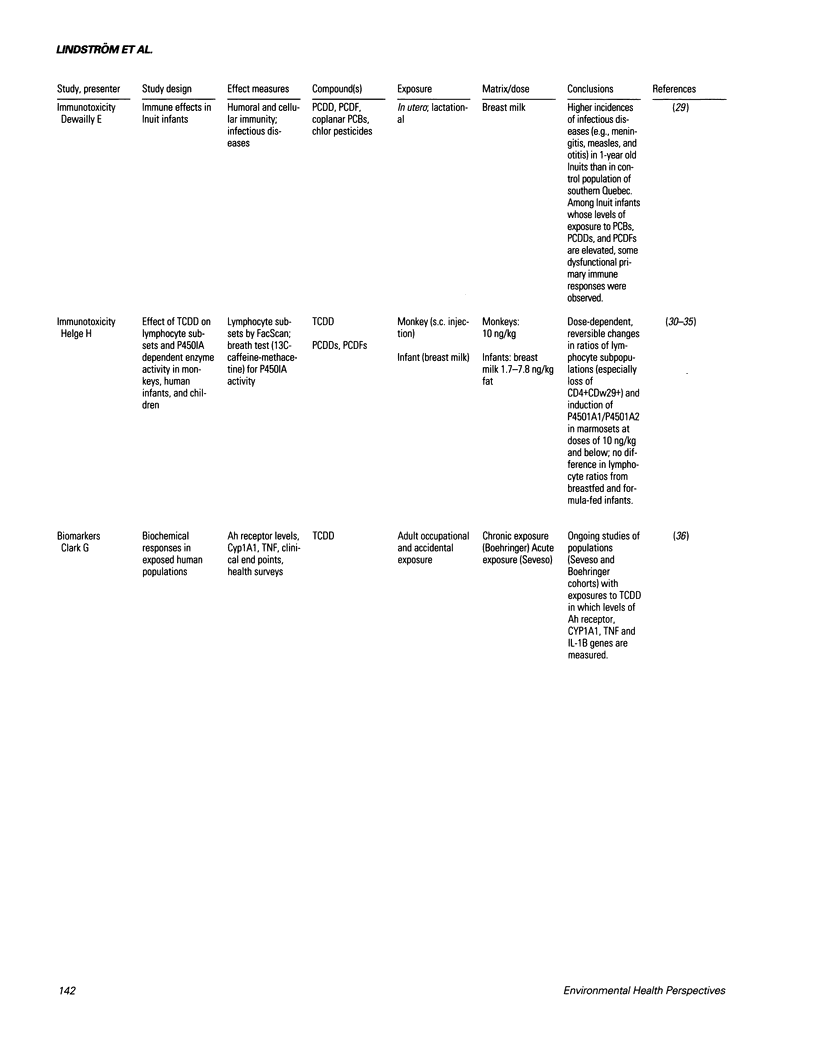
Selected References
These references are in PubMed. This may not be the complete list of references from this article.
- Bjerke D. L., Brown T. J., MacLusky N. J., Hochberg R. B., Peterson R. E. Partial demasculinization and feminization of sex behavior in male rats by in utero and lactational exposure to 2,3,7,8-tetrachlorodibenzo-p-dioxin is not associated with alterations in estrogen receptor binding or volumes of sexually differentiated brain nuclei. Toxicol Appl Pharmacol. 1994 Aug;127(2):258–267. doi: 10.1006/taap.1994.1160. [DOI] [PubMed] [Google Scholar]
- Bjerke D. L., Sommer R. J., Moore R. W., Peterson R. E. Effects of in utero and lactational 2,3,7,8-tetrachlorodibenzo-p-dioxin exposure on responsiveness of the male rat reproductive system to testosterone stimulation in adulthood. Toxicol Appl Pharmacol. 1994 Aug;127(2):250–257. doi: 10.1006/taap.1994.1159. [DOI] [PubMed] [Google Scholar]
- Chen Y. C., Guo Y. L., Hsu C. C., Rogan W. J. Cognitive development of Yu-Cheng ("oil disease") children prenatally exposed to heat-degraded PCBs. JAMA. 1992 Dec 9;268(22):3213–3218. [PubMed] [Google Scholar]
- Clark G., Tritscher A., Bell D., Lucier G. Integrated approach for evaluating species and interindividual differences in responsiveness to dioxins and structural analogs. Environ Health Perspect. 1992 Nov;98:125–132. doi: 10.1289/ehp.9298125. [DOI] [PMC free article] [PubMed] [Google Scholar]
- Fine J. S., Gasiewicz T. A., Fiore N. C., Silverstone A. E. Prothymocyte activity is reduced by perinatal 2,3,7,8-tetrachlorodibenzo-p-dioxin exposure. J Pharmacol Exp Ther. 1990 Oct;255(1):128–132. [PubMed] [Google Scholar]
- Fine J. S., Gasiewicz T. A., Silverstone A. E. Lymphocyte stem cell alterations following perinatal exposure to 2,3,7,8-tetrachlorodibenzo-p-dioxin. Mol Pharmacol. 1989 Jan;35(1):18–25. [PubMed] [Google Scholar]
- Gladen B. C., Rogan W. J. Effects of perinatal polychlorinated biphenyls and dichlorodiphenyl dichloroethene on later development. J Pediatr. 1991 Jul;119(1 Pt 1):58–63. doi: 10.1016/s0022-3476(05)81039-x. [DOI] [PubMed] [Google Scholar]
- Gladen B. C., Rogan W. J., Hardy P., Thullen J., Tingelstad J., Tully M. Development after exposure to polychlorinated biphenyls and dichlorodiphenyl dichloroethene transplacentally and through human milk. J Pediatr. 1988 Dec;113(6):991–995. doi: 10.1016/s0022-3476(88)80569-9. [DOI] [PubMed] [Google Scholar]
- Grandjean P., Weihe P., Jørgensen P. J., Clarkson T., Cernichiari E., Viderø T. Impact of maternal seafood diet on fetal exposure to mercury, selenium, and lead. Arch Environ Health. 1992 May-Jun;47(3):185–195. doi: 10.1080/00039896.1992.9938348. [DOI] [PubMed] [Google Scholar]
- Jacobson J. L., Jacobson S. W., Humphrey H. E. Effects of exposure to PCBs and related compounds on growth and activity in children. Neurotoxicol Teratol. 1990 Jul-Aug;12(4):319–326. doi: 10.1016/0892-0362(90)90050-m. [DOI] [PubMed] [Google Scholar]
- Jacobson J. L., Jacobson S. W., Humphrey H. E. Effects of in utero exposure to polychlorinated biphenyls and related contaminants on cognitive functioning in young children. J Pediatr. 1990 Jan;116(1):38–45. doi: 10.1016/s0022-3476(05)81642-7. [DOI] [PubMed] [Google Scholar]
- Krüger N., Helge H., Neubert D. CO2 breath tests using 14C-caffeine, 14C-methacetin and 14C-phenacetin for assessing postnatal development of monooxygenase activities in rats and marmosets. Dev Pharmacol Ther. 1991;16(3):164–175. [PubMed] [Google Scholar]
- Levin E. D., Schantz S. L., Bowman R. E. Delayed spatial alternation deficits resulting from perinatal PCB exposure in monkeys. Arch Toxicol. 1988;62(4):267–273. doi: 10.1007/BF00332486. [DOI] [PubMed] [Google Scholar]
- Levin E. D., Schantz S. L., Bowman R. E. Use of the lesion model for examining toxicant effects on cognitive behavior. Neurotoxicol Teratol. 1992 Mar-Apr;14(2):131–141. doi: 10.1016/0892-0362(92)90061-e. [DOI] [PubMed] [Google Scholar]
- Ness D. K., Schantz S. L., Moshtaghian J., Hansen L. G. Effects of perinatal exposure to specific PCB congeners on thyroid hormone concentrations and thyroid histology in the rat. Toxicol Lett. 1993 Jun;68(3):311–323. doi: 10.1016/0378-4274(93)90023-q. [DOI] [PubMed] [Google Scholar]
- Neubert R., Golor G., Stahlmann R., Helge H., Neubert D. Polyhalogenated dibenzo-p-dioxins and dibenzofurans and the immune system. 4. Effects of multiple-dose treatment with 2,3,7,8-tetrachlorodibenzo-p-dioxin (TCDD) on peripheral lymphocyte subpopulations of a non-human primate (Callithrix jacchus). Arch Toxicol. 1992;66(4):250–259. doi: 10.1007/BF02307170. [DOI] [PubMed] [Google Scholar]
- Neubert R., Stahlmann R., Korte M., van Loveren H., Vos J. G., Golor G., Webb J. R., Helge H., Neubert D. Effects of small doses of dioxins on the immune system of marmosets and rats. Ann N Y Acad Sci. 1993 Jun 23;685:662–686. doi: 10.1111/j.1749-6632.1993.tb35931.x. [DOI] [PubMed] [Google Scholar]
- Rier S. E., Martin D. C., Bowman R. E., Dmowski W. P., Becker J. L. Endometriosis in rhesus monkeys (Macaca mulatta) following chronic exposure to 2,3,7,8-tetrachlorodibenzo-p-dioxin. Fundam Appl Toxicol. 1993 Nov;21(4):433–441. doi: 10.1006/faat.1993.1119. [DOI] [PubMed] [Google Scholar]
- Rogan W. J., Gladen B. C., Hung K. L., Koong S. L., Shih L. Y., Taylor J. S., Wu Y. C., Yang D., Ragan N. B., Hsu C. C. Congenital poisoning by polychlorinated biphenyls and their contaminants in Taiwan. Science. 1988 Jul 15;241(4863):334–336. doi: 10.1126/science.3133768. [DOI] [PubMed] [Google Scholar]
- Rogan W. J., Gladen B. C., McKinney J. D., Carreras N., Hardy P., Thullen J., Tingelstad J., Tully M. Polychlorinated biphenyls (PCBs) and dichlorodiphenyl dichloroethene (DDE) in human milk: effects of maternal factors and previous lactation. Am J Public Health. 1986 Feb;76(2):172–177. doi: 10.2105/ajph.76.2.172. [DOI] [PMC free article] [PubMed] [Google Scholar]
- Rogan W. J., Gladen B. C., McKinney J. D., Carreras N., Hardy P., Thullen J., Tingelstad J., Tully M. Polychlorinated biphenyls (PCBs) and dichlorodiphenyl dichloroethene (DDE) in human milk: effects on growth, morbidity, and duration of lactation. Am J Public Health. 1987 Oct;77(10):1294–1297. doi: 10.2105/ajph.77.10.1294. [DOI] [PMC free article] [PubMed] [Google Scholar]
- Rogan W. J., Gladen B. C., McKinney J. D., Carreras N., Hardy P., Thullen J., Tinglestad J., Tully M. Neonatal effects of transplacental exposure to PCBs and DDE. J Pediatr. 1986 Aug;109(2):335–341. doi: 10.1016/s0022-3476(86)80397-3. [DOI] [PubMed] [Google Scholar]
- Rogan W. J., Gladen B. C. Neurotoxicology of PCBs and related compounds. Neurotoxicology. 1992 Spring;13(1):27–35. [PubMed] [Google Scholar]
- Rogan W. J., Gladen B. C. PCBs, DDE, and child development at 18 and 24 months. Ann Epidemiol. 1991 Aug;1(5):407–413. doi: 10.1016/1047-2797(91)90010-a. [DOI] [PubMed] [Google Scholar]
- Seegal R. F., Bush B., Brosch K. O. Comparison of effects of Aroclors 1016 and 1260 on non-human primate catecholamine function. Toxicology. 1991 Feb;66(2):145–163. doi: 10.1016/0300-483x(91)90215-m. [DOI] [PubMed] [Google Scholar]
- Seegal R. F. The neurochemical effects of PCB exposure are age-dependent. Arch Toxicol Suppl. 1994;16:128–137. doi: 10.1007/978-3-642-78640-2_15. [DOI] [PubMed] [Google Scholar]
- Smialowicz R. J., Riddle M. M., Williams W. C., Diliberto J. J. Effects of 2,3,7,8-tetrachlorodibenzo-p-dioxin (TCDD) on humoral immunity and lymphocyte subpopulations: differences between mice and rats. Toxicol Appl Pharmacol. 1994 Feb;124(2):248–256. doi: 10.1006/taap.1994.1029. [DOI] [PubMed] [Google Scholar]


